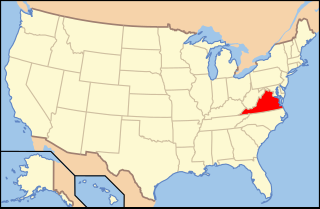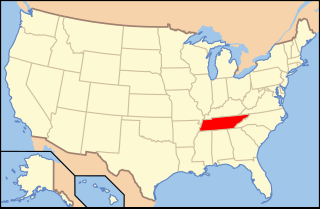The Andean-Saharan glaciation occurred during the Paleozoic from 450 Ma to 420 Ma, during the late Ordovician and the Silurian period. For the Ordovician/Saharan part, see the more extensive article on the Late Ordovician glaciation.

The Ordovician Martinsburg Formation (Om) is a mapped bedrock unit in Pennsylvania, New Jersey, Maryland, Virginia, and West Virginia. It is named for the town of Martinsburg, West Virginia for which it was first described. It is the dominant rock formation of the Great Appalachian Valley in New Jersey (where it is called Kittatinny Valley and Pennsylvania.

The Ordovician Reedsville Formation is a mapped surficial bedrock unit in Pennsylvania, Maryland, Virginia, West Virginia, and Tennessee, that extends into the subsurface of Ohio. This rock is a slope-former adjacent to the prominent ridge-forming Bald Eagle sandstone unit in the Appalachian Mountains. It is often abbreviated Or on geologic maps.

The Conococheague Formation is a mapped Appalachian bedrock unit of Cambrian age, consisting primarily of limestone and dolomite. It occurs in central Maryland, southern and central Pennsylvania, the Valley and Ridge of Virginia and easternmost West Virginia.

Paleontology in Virginia refers to paleontological research occurring within or conducted by people from the U.S. state of Virginia. The geologic column in Virginia spans from the Cambrian to the Quaternary. During the early part of the Paleozoic, Virginia was covered by a warm shallow sea. This sea would come to be inhabited by creatures like brachiopods, bryozoans, corals, and nautiloids. The state was briefly out of the sea during the Ordovician, but by the Silurian it was once again submerged. During this second period of inundation the state was home to brachiopods, trilobites and entire reef systems. During the mid-to-late Carboniferous the state gradually became a swampy environment.

Paleontology in Tennessee refers to paleontological research occurring within or conducted by people from the U.S. state of Tennessee. During the early part of the Paleozoic era, Tennessee was covered by a warm, shallow sea. This sea was home to brachiopods, bryozoans, cephalopods, corals, and trilobites. Tennessee is one of the best sources of Early Devonian fossils in North America. During the mid-to-late Carboniferous, the state became a swampy environment, home to a rich variety of plants including ferns and scale trees. A gap in the local rock record spans from the Permian through the Jurassic. During the Cretaceous, the western part of the state was submerged by seawater. The local waters were home to more fossil gastropods than are known from anywhere else in the world. Mosasaurs and sea turtles also inhabited these waters. On land the state was home to dinosaurs. Western Tennessee was still under the sea during the early part of the Cenozoic. Terrestrial portions of the state were swampy. Climate cooled until the Ice Age, when the state was home to Camelops, horses, mammoths, mastodons, and giant ground sloths. The local Yuchi people told myths of giant lizard monsters that may have been inspired by fossils either local or encountered elsewhere. In 1920, after local fossils became a subject of formal scientific study, a significant discovery of a variety of Pleistocene creatures was made near Nashville. The Cretaceous bivalve Pterotrigonia thoracica is the Tennessee state fossil.
The Black River Group is a geologic group in Illinois and West Virginia. It preserves fossils dating back to the Ordovician period.
The Lincolnshire Limestone is a geologic formation in Virginia. It preserves fossils dating back to the Ordovician period.

The Roubidoux Formation is a geologic formation in the Ozarks of Missouri and in Virginia. It preserves fossils dating back to the Ordovician period.
The Moccasin Formation is a geologic formation in Virginia. It preserves fossils dating back to the Ordovician period.
The Longview Formation is a geologic formation in Virginia. It preserves fossils dating back to the Ordovician period.
The Liberty Hall Formation is a geologic formation in Virginia. It preserves fossils dating back to the Ordovician period.
The Oranda Formation is a geologic formation in Virginia. It preserves fossils dating back to the Ordovician period.
The Rockdale Run Formation is a geologic formation in Maryland, Pennsylvania, Virginia and West Virginia. It preserves fossils dating back to the Ordovician period.
The Chepultepec Formation, or Chepultepec Dolomite, is a geologic formation in the Appalachian regions of Eastern North America. It is named after a former town in Alabama, where it was first described. It preserves fossils dating back to the Ordovician period.
The Chambersburg Formation is a geologic formation in Virginia. It preserves fossils dating back to the Ordovician period.
The Whitesburg Formation is a dark limestone with interbedded shales geologic formation in Tennessee and Virginia.. It preserves fossils dating back to the Ordovician period.
The St. Paul Group is a geologic group in West Virginia. It dates back to the Ordovician period.
The Oswego Formation is a geologic formation in West Virginia. It dates back to the Ordovician period.
The Wells Creek Formation is a geologic formation in West Virginia. It dates back to the Ordovician period.






